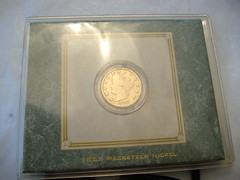Grading A Gold Coin: How The Sheldon Scale Helps Determine Value

Grading A Gold Coin: How The Sheldon Scale Helps Determine Value
One of the most exciting aspects of collecting coins is discovering how much a prized piece is worth. Even if you don’t plan on selling anything from your collection, it is still important to know the value of what you have. Before taking anything out for an official estimate, however, you should learn a little bit about what the appraiser will look for and what his or her final grade for your gold coin actually means.
Today in the U.S., most coins are appraised using a system called the Sheldon Scale. This scale was developed in part as a way to standardize how rare coins are assigned value. It uses a combination of numbers (from 1 to 70) and adjectives (from “poor” to “mint state”) in an attempt to determine how the various scratches, nicks, dings, and other marks on coins affects their overall value to collectors. For example, a rating of EF-40 (“extremely fine”) means the gold coin may be a bit worn, but all of the major design elements and devices are clear. Although there are 70 grades on the Sheldon Scale, only about 15-20 of them are used with regularity.
When you take a gold coin to a certified appraiser, here are some of the characteristics he or she will look at before determining a grade. If you plan on selling or buying gold for investment purposes, then you must familiarize yourself with this process so you can become adept at evaluating your own pieces. This will reduce the chances of someone taking advantage of you.
* General state. The first thing the appraiser will do is gauge the general state of your gold coin. Based on the luster, degree of wear, number of imperfections, and visual appeal, it will be placed it into one of three categories: Circulated, About Uncirculated, o Uncirculated (or Mint State).
* Planchet condition. Planchets are the round metal discs upon which the details of coins are stamped. Appraisers will inspect your item for flaws such as raised, peeled, or even missing metal. These kinds of deformities tend to lower values significantly, so steer clear of them when buying gold pieces for your collection. On the other hand, errors that occur when the mint uses a deformed or incorrect planchet could make your token worth more.
* Die quality and striking characteristics. Coins might exhibit imperfections due to flawed dies used during the stamping process. Common die problems include clash marks, cracks, rust, scratches, and excessive wear. Unusual striking characteristics include things like off-center strikes and double strikes. Coins bearing mint errors like these seldom enter into circulation, making them highly sought after by collectors interested in buying gold.
Once coins are evaluated based on these criteria, Sheldon Scale grades will be assigned. Just remember that grading coins is a very subjective task, so don’t be surprised if two professionals give you slightly different appraisals.
You might find it helpful to buy additional books or magazines about the grading process so you can further increase your knowledge of the different ratings. The more you know, the better decisions you will make when selling or buying gold.
Related Coin Values Articles
Recommended Reading
- Canadian Coins
- Krugerrand Gold Coin Prices
- Numismatic Gold Coins
- Tips For Silver Coin Investing
- Books of great value to compliment the book Coin Collecting Starts Here
Related posts:
- Do not know Gold coin Grading Program Essential? Do not know Gold coin Grading Program Essential? Coin amassing is a popular interest to a lot of men and women of all ages. Your marketing regarding cash offers expanded...
